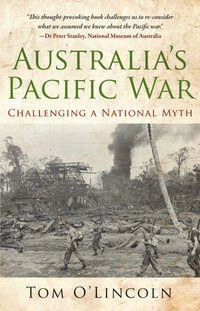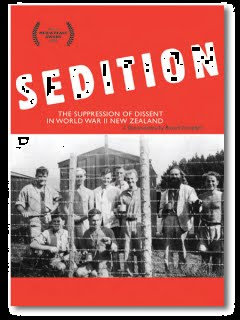
Part of the great ideological power of ANZAC Day now is the way it mobilises imagery stressing the pity and sorrow of war in order to strengthen militarism and Australia and New Zealand’s military role in the world. Few events grant the armed forces such opportunities for public display and social legitimacy; fewer still so successfully de-politicise the discussion of political questions. When Marilyn Lake and Henry Reynolds brought out their collection What’s Wrong With ANZAC : The Militarism of Australian History last year, they faced sustained hostile commentary from both the liberal and right-wing press. In New Zealand it’s taken a legal battle right through to the Supreme Court to establish that free-speech principles stand on April 25th.
The event’s power is recent, and remarkable: baby boomers I’ve spoken to marvel at the transformation of the unpopular, poorly attended and jingoistic events of their youth into the well-nigh universally marked dawn services of today. Part of this appeal is no doubt to do with the passing of the generation who fought in World War Two – I remember that as my own half-formed justification when, as a teenager, I turned out in Queen’s Gardens – but, whatever our individual and complex emotional feelings about loved ones and relatives, the political and social consequences of ANZAC Day’s revival are everywhere evident, and damaging.
This ANZAC Day I was flying home from the Marxism conference in Melbourne, an event where I’d been lucky enough to be able to attend the launch of Tom O’Lincoln’s new book Australia’s Pacific War: Challenging a National Myth. This book is an excellent, and sorely needed, corrective to the nationalist and pro-war mythology bolstering Australian military and imperial ambitions, and informing the cultural work on ANZAC Day – Australia’s Pacific War is an anti-war counterblast, a critical account of how Australia and its allies fought in the Pacific theatre of World War Two.

The Pacific War has a particular significance in the mythology of contemporary Australian imperialism: for all the drunken revelry of backpapers taking time out from their OEs to worship at Gallipoli each year, World War One offers slim pickings for today’s apologists for war. Widely accepted as an exercise in bloody futility, distant, confused; the First World War serves too easily in the anti-war narrative for the right ever to have bothered much with its reclamation. (The grubby role of Australian and New Zealand troops propping up British colonialism doesn’t help here either: characters in Naguib Mahfouz’s Cairo Trilogy use the term “Australian” as a catch-phrase for abusers, pillagers and thugs). Against this, Australia’s actions in the Pacific can be connected to myths of the Second World War as the “good war”, for Australian independence against Japanese aggression, for freedom and democracy, for liberty against empire. It’s a myth which has suited many an imperial venture since.
“What I mean by the Pacific War myth,” O’Lincoln explains, “is a mass phenomenon, in which an elaborate belief system sustains social mobilisation…Instead of a fantasy of inevitable victory, we find a fantasy affirming the inherent validity of national war mobilisation – a national myth that underpins war-making today.” (viii). Replacing older, cruder myths of “inevitable victory” is in part what gives ANZAC Day its ideological force: mourning and recognising the dead, now, provides unwitting support for the set-up that ensured their death.
Australia’s Pacific War sets out an historical record very different to that the myth of the “good war” encourages us to imagine. Australia was never under threat from a Japanese invasion, and its rulers knew this. The fear of that invasion, though, was cleverly developed and exploited by the Labor government of the time to justify and extend war policies abroad and industrial exploitation at home. (Labour’s vile role suppressing civil liberties in both Australia and New Zealand deserves more attention: see, for NZ, Russell Campbell’s documentary Sedition).

Drawing on racist campaigns against the Japanese of long standing, Australia’s media and political forces used the war to whip up popular loathing and a de-humanising of the enemy. Where anti-Nazi propaganda focused on Germany’s leaders, anti-Japanese material was generalising, and deeply racist. O’Lincoln quotes from an article on “The Japanese as a Fighter” in the Melbourne Argus :
He was a mass of contradictions – he fought grimly, enduring terrible wounds, until he was destroyed; or he ran in screaming fear; or he blew himself to pieces with a grenade clutched to his chest or stomach. He was cruel and dirty and bestial. He killed his wounded rather than have them fall into our hands. He plundered and raped the natives. The Australians and Americans came to loathe him as one loathes something that is dirty and ratlike.
And this appeared after the bombing of Hiroshima and Nagasaki! Politicians exploit this set of associations still; O’Lincoln quotes Alexander Downer in the early days of the “war on terror” referring to “monsters such as Hitler, Mussolini and Tojo.” Even George Bush himself wasn’t as capacious in his genealogies of the Axis of Evil.

Australia’s Pacific War details the Australian army’s role in sustaining British – and Australian – colonial domination in the Asia-Pacific region; Australia’s invasion of East Timor; racism in the occupation of the Japan and repression of the Japanese labour movement; and the impact of the war on democratic liberties and class struggle at home. Life for people in colonised countries under Japanese rule could be very unpleasant: in this, it differed little from life under any of the other competing colonial forces in the region. O’Lincoln quotes from a diary of an Australian soldier:
The private local war [in East Timor], Portuguese versus native, still goes on in its bloodthirsty way, and provides some humour for sub units. One of our patrols near Mape, out hunting the Jap, encountered a Portuguese patrol out hunting some natives, they exchanged compliments and went their various ways.
This all makes for grim, but important, reading, but Australia’s Pacific War isn’t just a chronicle of war’s horrors. O’Lincoln includes chapters on unrest on the homefront – industrial unrest, certainly, but also changing attitudes to gender and sexuality – and considers some of the experience of ordinary soldiers in Japan, and how these human encounters changed their attitudes and actions. There’s plenty on the ongoing resistance of indigenous people – in Australia and in colonies abroad – to the treatment they received from occupying forces.
Australia’s Pacific War is written to “challenge conventional views of the war.” I hope it does.
Sources
Tom O’Lincoln’s website has some excerpts from the book, as well as supplementary material on questions it raises – on the (compromised and occasionally horrifying) position of Communists in Australia towards the war, on labour in the war, and more.
ANZAC Day has been a site of social conflict and contestation as well as forced unity: read Kyla Cassell’s very good article here (PDF) on class conflict at ANZCAC Day celebrations between the wars.
I spent Anzac Day reading this book on a bench in Melbourne Airport, having missed my flight. What struck me was one comment from, I think the Prime Minister of the time, that the war was necessary to defend the free peoples of Asia - when there were in fact none at the time. I suppose the thinking was that peoples enslaved by countries that had some limited democratic rights at home were more free than those enslaved by countries with autocracies.
ReplyDelete